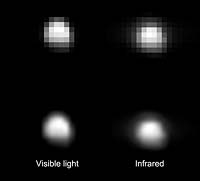|
COMETS EARTH JUPITER KUIPER BELT MARS MERCURY METEORITES NEPTUNE OORT CLOUD PLUTO SATURN SOLAR SYSTEM SPACE SUN URANUS VENUS ORDER PRINTS
PHOTO CATEGORIES SCIENCEVIEWS AMERICAN INDIAN AMPHIBIANS BIRDS BUGS FINE ART FOSSILS THE ISLANDS HISTORICAL PHOTOS MAMMALS OTHER PARKS PLANTS RELIGIOUS REPTILES SCIENCEVIEWS PRINTS
|
Related Documents
Download Options
On June 8, 2011, the visible and infrared mapping spectrometer aboard NASA's Dawn spacecraft captured the instrument's first images of Vesta that are larger than a few pixels, from a distance of about 218,000 miles (351,000 kilometers). The images were taken for calibration purposes. Images obtained in the visible part of the light spectrum, at about 0.55 microns in wavelength, appear on the left. Images obtained in the infrared spectrum, at around 3 microns in wavelength, appear on the right. The spatial resolution of these images is about 60 miles (90 kilometers) per pixel. The visible and infrared mapping spectrometer will be able to provide images of Vesta in 432 wavelengths, which will help scientists determine the composition of Vesta. The Dawn mission is managed by NASA's Jet Propulsion Laboratory in Pasadena, Calif., for the agency's Science Mission Directorate in Washington. Dawn is a project of the directorate's Discovery Program, managed by NASA's Marshall Space Flight Center in Huntsville, Ala. UCLA is responsible for overall Dawn mission science. Orbital Sciences Corp. of Dulles, Va., designed and built the Dawn spacecraft. Dawn's visible and infrared mapping spectrometer was provided by the Italian Space Agency and is managed by Italy's National Institute for Astrophysics, in collaboration with Selex Galileo, where it was built. |
